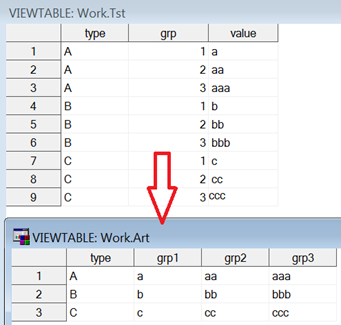In Art Carpenter’s latest book, Carpenter’s Guide to Innovative SAS Techniques, a data step approach to transpose data (from long to wide) works like (Ch2.4.2):
data tst;
input type $ grp value $3.;
datalines;
A 1 a
A 2 aa
A 3 aaa
B 1 b
B 2 bb
B 3 bbb
C 1 c
C 2 cc
C 3 ccc
;data art(keep=type grp1-grp3);
set tst;
by type;
retain grp1-grp3 ;
array grps {3} $ grp1-grp3;
if first.type then do i = 1 to 3;
grps{i} = “ “;
end;grps{grp} = value;
if last.type then output art ;
run;
And such logic can be best demonstrated by a DoW Loop:
data dow(keep=type grp1-grp3);
array grps[3] $ grp1-grp3;
do n = 1 by 1 until(last.type);
set tst;
by type;
grps[grp]=value;
end;
run;
/Note/
1. The traditional PROC TRANSPOSE approach:
proc transpose data=tst
out=trans(drop=_:)
prefix=grp;
by type;
id grp;
var value;
run;
2. Why use data step approach (both Art and DoW) to transpose data against the TRANSPOSE procedure:
- it’s much faster since data step array used
- save codes when complex transformation needed
- last but not least, it’s cool!
3. Arthur Tabachneck maintains a general data step transposing macro, %transpose and you can call it like:
%transpose(data=tst, out=mac,
by=type, var=value,
id=grp)

